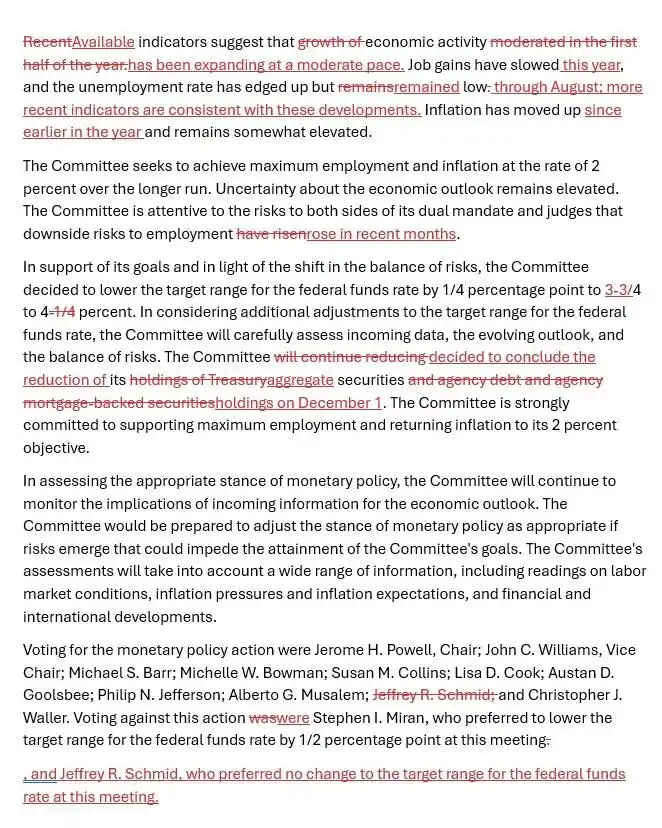The Federal Reserve launches a combination move: continues to cut interest rates by 25 basis points and ends balance sheet reduction in December, with two committee members opposing the rate decision.
Trump-appointed governor Milan, as before, advocates a 50 basis point rate cut, while another voting member, Schmid, supports holding rates steady.
Original Title: "The Federal Reserve Launches a Combination Punch: Another 25 Basis Point Rate Cut + Ending Balance Sheet Reduction in December, Two Voting Members Oppose Rate Decision"
Original Author: Li Dan, Wallstreetcn
Key Points:
· The Federal Reserve has cut rates by 25 basis points for the second consecutive time, in line with market expectations.
· The Fed's balance sheet reduction ends after three and a half years, with a decision to replace maturing MBS holdings with short-term Treasuries starting in December.
· Of the two FOMC voting members who opposed the rate decision, Trump-appointed newcomer Milan, as in the previous meeting, advocated for a 50 basis point cut, while Kansas City Fed President Schmid supported holding rates steady.
· The statement reiterated that the rate cut was decided "in light of the shift in risk balance," replaced "recent" data indicators with "available" ones, newly noted that recent labor market indicators are consistent with pre-government shutdown trends, and stated that downside employment risks have "increased in recent months."
· "New Fed News Agency": The Fed continues efforts to prevent the recent slowdown in employment from worsening, but missing economic data makes the future direction of rates increasingly uncertain.
The Federal Reserve, as the market expected, continued its rate-cutting actions and decided to abandon quantitative tightening (QT), planning to end balance sheet reduction one month later.
On Wednesday, October 29, Eastern Time, after the FOMC monetary policy meeting, the Fed announced it would lower the target range for the federal funds rate from 4.00%-4.25% to 3.75%-4.00%, a cut of 25 basis points. After the first rate cut of the year at the last meeting, this is the first time in a year that the Fed has cut rates at two consecutive FOMC meetings.
This rate cut decision was entirely expected by investors. By Tuesday's close, CME tools showed that the futures market priced in a 99.9% probability of a 25 basis point rate cut this week, and a 91% probability of another 25 basis point cut at the next meeting in December. This indicates that the market has almost fully priced in a total of three rate cuts this year. The rate outlook released after the September FOMC meeting showed that most Fed policymakers expected three rate cuts this year, up from two in June.
As with the previous two meetings, the Fed's decision-makers did not reach consensus on rate actions at this meeting. Two FOMC members, including Trump-appointed new governor Milan, voted against the 25 basis point cut, reflecting ongoing internal divisions. Unlike before, this time there were differences both in the magnitude of the cut and whether to continue further action.
The Fed announced this time that it would end the QT balance sheet reduction starting in December, but this was not unexpected. Two weeks ago, Fed Chair Powell had already hinted at stopping balance sheet reduction, saying that bank reserves remained ample and might reach the level needed to stop QT in the coming months. An article by Wallstreetcn this week mentioned that most major Wall Street banks, including Goldman Sachs and JPMorgan, expected the Fed to announce the end of QT this week due to recent signs of liquidity stress in the money markets.
After the release of this decision statement, Nick Timiraos, a senior Fed reporter known as the "New Fed News Agency," wrote:
"The Fed has cut rates by another 25 basis points, but missing (economic) data makes the future direction increasingly uncertain."
"The Fed has cut rates at two consecutive meetings, continuing efforts to prevent the recent employment slowdown from worsening. In the process of unwinding the Fed's aggressive rate hikes, the easiest part may already be done, and officials are now discussing the next step in rate cuts. The task is made even more complicated by missing data due to the government shutdown."
Balance Sheet Reduction Ends After Three and a Half Years, Short-Term Treasuries to Replace Maturing MBS Holdings
The main difference in the post-meeting statement compared to the last one is the adjustment to balance sheet reduction.
The statement no longer reiterates that the Fed will continue to reduce its holdings of US Treasuries, agency debt, and agency mortgage-backed securities (MBS), but instead clearly states:
"The (FOMC) Committee has decided to end the reduction of its aggregate securities holdings as of December 1."
This means the Fed's balance sheet reduction will end after three and a half years.
The Fed began balance sheet reduction on June 1, 2022. In June last year, it first slowed the pace, lowering the maximum monthly reduction of Treasuries from $35 billion to $25 billion. In April this year, it further slowed, lowering the monthly cap for Treasuries to $5 billion, while keeping the monthly redemption cap for agency debt and agency MBS at $35 billion.
The monetary policy implementation statement released by the Fed on Wednesday showed:
For US Treasuries maturing in October and November, the Fed will roll over the portion of principal payments exceeding the $5 billion monthly cap through auctions, and from December 1, will roll over the principal of all Treasuries through auctions.
For agency debt and agency MBS holdings maturing in October and November, the Fed will roll over the portion of principal payments exceeding the $35 billion monthly cap, and from December 1, will reinvest all principal payments from agency securities into Treasury bills.
This means that after stopping the balance sheet reduction plan in December, the Fed will reinvest MBS redemption principal into short-term US Treasuries, replacing maturing MBS holdings with short-term Treasuries.
Regarding the decision to end QT, Timiraos pointed out that Fed officials have long said they would stop QT once signs emerged in the overnight lending market that banks' cash holdings were no longer in large surplus. Over the past week, these signals have become increasingly apparent. The Fed will begin replacing maturing bond holdings with short-term Treasuries starting in December.
Dissenting Voter Milan Insists on 50 Basis Point Cut, Schmid Supports Holding Steady
The second major difference in this Fed decision statement is the FOMC voting result. The number of dissenting votes increased by one compared to the last meeting, matching the penultimate meeting at the end of July.
The voting results show that Powell and ten other voting members supported another 25 basis point rate cut. Of the two dissenters, interim Fed governor Milan, who took office before the September FOMC meeting, maintained his aggressive stance from the previous meeting, still hoping for a 50 basis point cut. Kansas City Fed President Jeffrey Schmid dissented because he supported keeping rates unchanged.
This is in stark contrast to the voting at the end of July FOMC meeting. At that time, two people voted against the decision to pause rate cuts. The two dissenters—Fed Governor Waller and Trump-nominated Fed Vice Chair for Supervision Bowman—both favored a 25 basis point cut at that time.
Bob Michele, Global Head of Fixed Income at JPMorgan Asset Management, commented that Powell is losing control of the Fed. A "persuasive" leader is needed for the Fed. Trump may have to install US Treasury Secretary Bessent at the Fed to promote Trump's own rate policy views.
Recent Labor Market Indicators Consistent with Pre-Government Shutdown Trends, Downside Employment Risks "Increased in Recent Months"
The difference in this Fed decision compared to the last one is also reflected in the description of the economic situation. The adjustments mainly reflect the impact of the US federal government shutdown since October, which has delayed the release of various economic data.
The previous statement began by reiterating that "recent indicators show economic growth moderated in the first half of the year," while this time "recent" was replaced with "available," stating:
"Available indicators show that the pace of economic expansion has moderated."
The previous statement said, "Job growth has slowed, the unemployment rate has edged up but remains low. Inflation has increased and remains somewhat elevated." This time, a time frame was added to the labor market and inflation trends, and it was newly noted that recent labor market indicators are consistent with trends reflected in data released before the government shutdown. The statement reads:
"Job growth has slowed this year, the unemployment rate has edged up but remained low as of August; more recent indicators are also consistent with these trends. Inflation has increased since the beginning of the year and remains somewhat elevated."
The above new statements are consistent with Powell's remarks two weeks ago. At that time, he said: "Based on the data we have, it is fair to say that since our September meeting four weeks ago, the outlook for jobs and inflation does not seem to have changed much."
As in the previous statement, this statement also says that the rate cut decision was made "in light of the shift in risk balance."
This statement again reiterates that the FOMC Committee is focused on the dual mandate of achieving maximum employment and price stability, and largely follows the previous statement's new judgment that downside employment risks have increased, with the only difference being the addition of a time qualifier for this risk change.
This statement no longer says, as in the previous one, that the FOMC "judges that downside employment risks have increased," but instead states, "The (FOMC) Committee is attentive to the risks to its dual mandate and judges that downside employment risks have increased in recent months."
The following red text shows the deletions and additions in this decision statement compared to the last one.

Disclaimer: The content of this article solely reflects the author's opinion and does not represent the platform in any capacity. This article is not intended to serve as a reference for making investment decisions.
You may also like
Changpeng Zhao Clarifies Personal BNB Holdings Policy

When being the "chief trader" is not enough, is Trump going to "run the show" himself?
As Wall Street's "mainstream players" rush to enter the market, Trump—who naturally attracts attention and controversy—clearly does not want to miss out on this grand feast.


